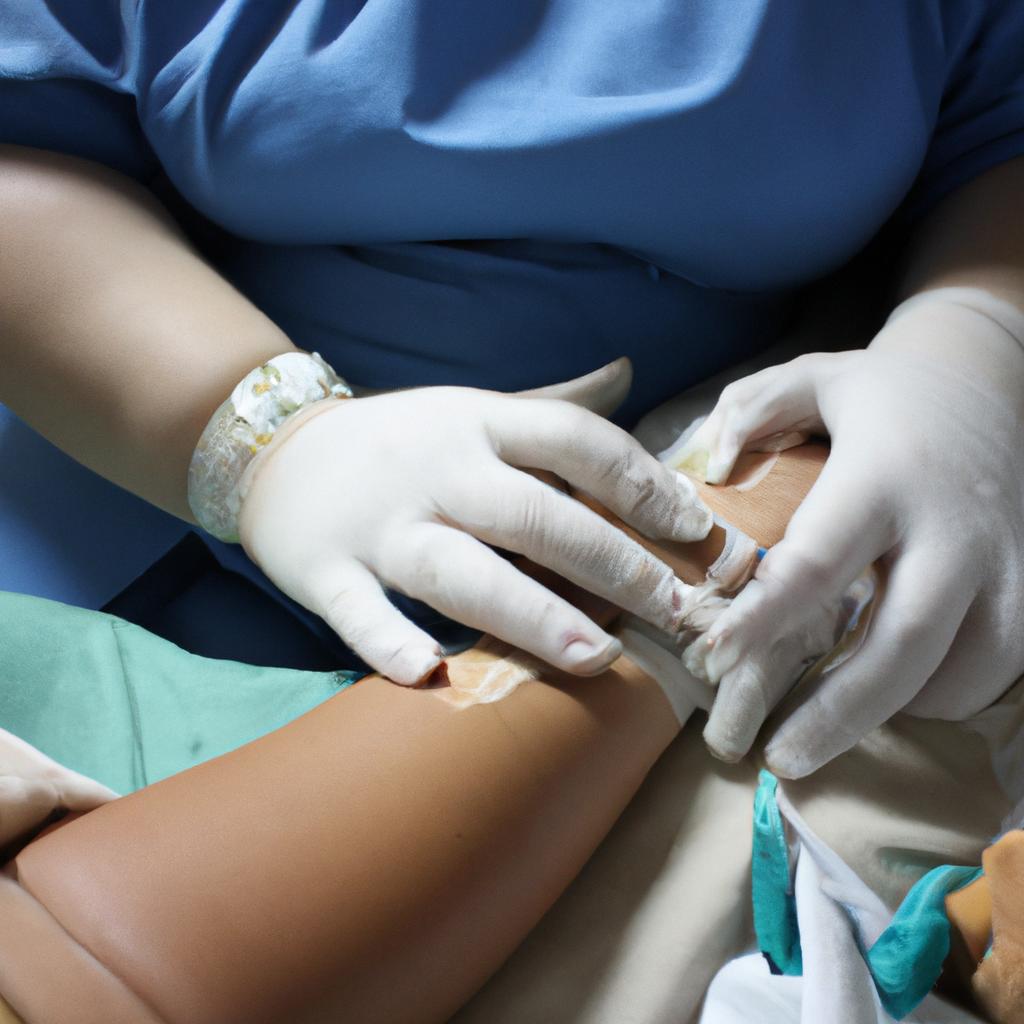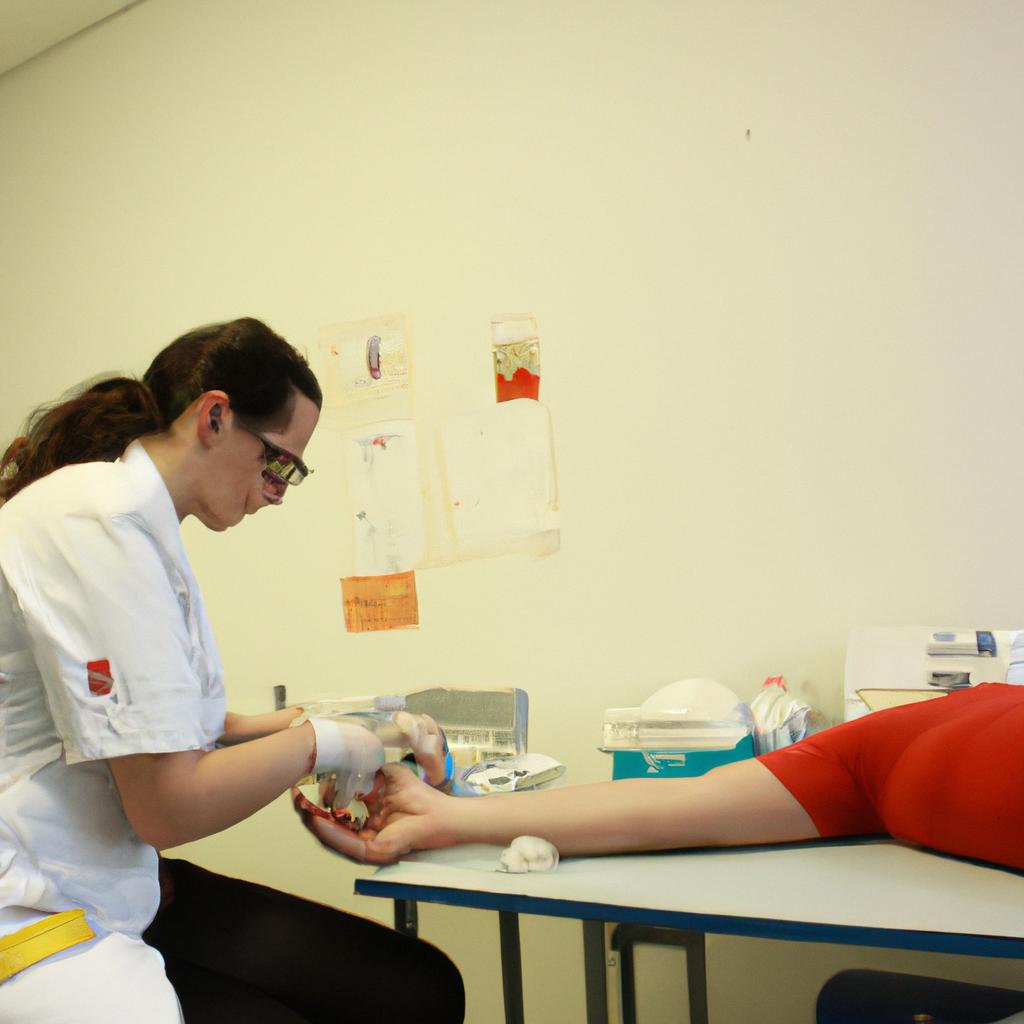Inflammation: Body Myositis in Juvenile Myositis

Juvenile Myositis (JM) is a rare autoimmune disease characterized by chronic inflammation in the muscles, skin, and other organs of children. It presents significant challenges for both patients and healthcare providers due to its complex nature and variable clinical manifestations. This article aims to explore one specific aspect of JM: Body Myositis, which refers to the inflammation primarily affecting the skeletal muscles. By examining the pathophysiology, symptoms, diagnosis, and potential treatment options for Body Myositis in JM patients, this article seeks to provide a comprehensive understanding of this debilitating condition.
Imagine an 8-year-old child named Sarah who suddenly develops muscle weakness along with rashes on her face and fingers. Despite being previously healthy, she struggles with simple tasks like climbing stairs or lifting heavy objects. Concerned parents take her to multiple physicians before receiving a diagnosis of Juvenile Myositis – specifically Body Myositis subtype. Such cases highlight the urgent need for increased awareness and knowledge about this particular manifestation of JM as it significantly impacts the quality of life for affected children. Understanding the underlying mechanisms behind Body Myositis can aid in early detection, prompt intervention, and improved management strategies for these young patients.
Overview of Inflammatory Myopathies
Overview of Inflammatory Myopathies
Inflammatory myopathies encompass a group of rare autoimmune diseases characterized by inflammation and weakness in the muscles. These conditions can affect individuals of all age groups, with some variants specifically targeting children and adolescents. One example that highlights the impact of these inflammatory myopathies is the case study involving a 12-year-old girl named Emily.
Example Case Study:
Emily began experiencing muscle weakness and fatigue, which gradually worsened over several months. She struggled with simple tasks such as climbing stairs or lifting objects. Upon examination, her muscles appeared inflamed, and blood tests revealed elevated levels of muscle enzymes indicative of muscle damage. Further diagnostic evaluations confirmed the presence of juvenile dermatomyositis (JDM), one specific type of inflammatory myopathy affecting children.
The complex nature of inflammatory myopathies necessitates an understanding of their various subtypes and clinical manifestations. To provide clarity on this topic, below are four key points to consider:
- Types: Inflammatory myopathies encompass different subtypes, including adult polymyositis (PM), adult dermatomyositis (DM), inclusion body myositis (IBM), necrotizing autoimmune myopathy (NAM), immune-mediated necrotizing myopathy (IMNM), and JDM.
- Characteristics: While each subtype exhibits distinct features, common symptoms include muscle weakness, fatigue, pain, stiffness, difficulty swallowing or breathing, skin rashes or discoloration, and joint involvement.
- Diagnostic Tools: Diagnosis relies on a combination of factors such as patient history, physical examination findings like proximal muscle weakness and characteristic rash patterns for DM/JDM cases, laboratory tests measuring muscle enzyme levels or autoantibodies associated with specific subtypes, electromyography studies evaluating electrical activity in affected muscles, imaging techniques like magnetic resonance imaging (MRI) or computed tomography (CT) scans to assess muscle inflammation, and muscle biopsies.
- Treatment Options: The management of inflammatory myopathies typically involves a multidisciplinary approach combining pharmacotherapy, physical therapy, occupational therapy, and regular monitoring by healthcare professionals. Medications may include corticosteroids to reduce inflammation, immunosuppressants to modulate the immune response, or other targeted therapies.
Table: Comparison of Common Inflammatory Myopathies
| Subtype | Age Group | Key Features |
|---|---|---|
| Polymyositis (PM) | Adults | Progressive muscle weakness |
| Dermatomyositis (DM) | Adults | Muscle weakness + skin involvement |
| Inclusion Body Myositis (IBM) | Older adults (>50 years) | Distal muscles affected more than proximal muscles |
| Juvenile Dermatomyositis (JDM) | Children/Adolescents | Proximal muscle weakness + characteristic rash |
Understanding these key aspects provides a foundation for comprehending juvenile dermatomyositis in greater detail. With JDM being one specific variant affecting children and adolescents, the subsequent section will delve into its pathogenesis, clinical presentation, diagnostic criteria, treatment options, and potential complications.
Understanding Juvenile Dermatomyositis
To fully understand the complexity of juvenile myositis, it is crucial to delve into specific types of inflammatory myopathies. One such type is body myositis, which primarily affects skeletal muscles and can have significant implications for young individuals. To illustrate the impact of this condition, let us consider a hypothetical case study.
Imagine a 12-year-old girl named Emily who has been experiencing progressive muscle weakness and fatigue over the past few months. Despite these symptoms, she had always been an active child with no prior medical history. After numerous doctor visits and diagnostic tests, Emily was diagnosed with body myositis, a subtype of juvenile myositis characterized by chronic inflammation in her skeletal muscles.
This diagnosis brings forth various challenges that both Emily and her family must confront:
- Physical limitations: The persistent muscle weakness restricts Emily’s ability to engage in physical activities she once enjoyed.
- Psychological impact: Coping with a chronic illness at such a young age can lead to emotional distress, feelings of isolation, and anxiety.
- Educational adjustments: The need for frequent medical appointments and potential complications may necessitate modifications in school attendance or accommodations.
- Social interactions: Participating in social events might become challenging due to physical limitations or concerns about appearance related to medication side effects.
To better comprehend the complexities surrounding body myositis in juvenile patients like Emily, we can refer to Table 1 below:
| Challenges Faced by Individuals with Body Myositis |
|---|
| Physical Limitations |
| Psychological Impact |
| Educational Adjustments |
| Social Interactions |
Table 1: Challenges faced by individuals diagnosed with body myositis.
Despite these obstacles, countless children bravely face the adversity presented by body myositis on a daily basis. By understanding their struggles and providing appropriate support systems, we can foster a more inclusive and empathetic environment for those affected by this condition.
In the subsequent section about “Causes and Risk Factors of Inflammatory Myopathies,” we will delve into the underlying factors that contribute to the development of these conditions. This understanding is vital in formulating effective prevention strategies and treatment approaches.
Causes and Risk Factors of Inflammatory Myopathies
Understanding Juvenile Myositis: Body Myositis in Inflammatory Myopathies
Consider the case of Sarah, a 9-year-old girl who recently experienced muscle weakness and pain. After visiting her doctor, she was diagnosed with juvenile dermatomyositis (JDM), an autoimmune disease characterized by inflammation of the muscles and skin. JDM is one form of inflammatory myopathy, a group of disorders that affect the muscles and cause varying degrees of muscle weakness. To comprehend the complexities of these conditions further, it is crucial to explore their causes and risk factors.
Inflammatory myopathies, including JDM, can arise from a combination of genetic predisposition and environmental triggers. While specific genes have been implicated in some cases, such as HLA class II alleles associated with JDM susceptibility, there are likely multiple contributing factors involved. Potential environmental triggers include infections like viruses or bacteria, exposure to certain medications, or even physical trauma. Research is ongoing to better understand the interplay between genetics and environmental factors in the development of inflammatory myopathies.
To grasp this intricate relationship between genetics and environment in inflammatory myopathies, let us consider four key points:
- Genetic variations may increase an individual’s susceptibility to developing inflammatory myopathies.
- Environmental triggers play a significant role in initiating or exacerbating symptoms.
- The exact mechanisms by which genetics and environment interact remain incompletely understood.
- Studying both genetic and environmental components is essential for comprehensive treatment approaches.
| Susceptibility Factors | Environmental Triggers | Interactions |
|---|---|---|
| Genetics | Infections | Complex |
| Medications | ||
| Physical Trauma |
This table highlights how different elements contribute to the overall picture of inflammatory myopathies. It underscores how each person’s unique genetic makeup interacts with various environmental factors, leading to the development and progression of these conditions.
Understanding the causes and risk factors of inflammatory myopathies is crucial for healthcare professionals in providing appropriate diagnosis and treatment. By recognizing the interplay between genetic predisposition and environmental triggers, clinicians can tailor interventions to individual patients’ needs, aiming for optimal outcomes.
Moving forward, we will delve into the signs and symptoms associated with juvenile dermatomyositis, further expanding our understanding of this complex autoimmune disease that affects both muscles and skin.
Signs and Symptoms of Juvenile Dermatomyositis
Exploring the causes and risk factors of inflammatory myopathies can shed light on the underlying mechanisms that contribute to these conditions. By understanding these factors, healthcare professionals can better diagnose and manage patients with such disorders. To illustrate, let us consider a hypothetical case study involving a 12-year-old girl named Emily who has been recently diagnosed with juvenile dermatomyositis.
Case Study:
Emily is an active young girl who enjoys participating in various sports activities. However, over the past few months, she began experiencing muscle weakness and fatigue. Her parents noticed her struggling to climb stairs or lift heavy objects. Concerned about her declining physical abilities, they took Emily to see a rheumatologist.
Paragraph 1:
Inflammatory myopathies, including juvenile dermatomyositis like Emily’s case, have multifactorial origins. While their exact causes remain unknown, several risk factors have been identified through research and clinical observations. These include:
- Genetic predisposition: Certain genetic variations may increase an individual’s susceptibility to developing inflammatory myopathies.
- Autoimmune dysfunction: Dysfunction within the immune system can lead to chronic inflammation in the muscles.
- Environmental triggers: Exposure to certain environmental factors, such as infections or toxins, could trigger an autoimmune response leading to myopathy.
- Hormonal influences: Hormonal imbalances have also been implicated in some cases of inflammatory myopathies.
To gain a deeper understanding of these potential causes and risk factors for inflammatory myopathies, researchers continue to investigate through studies and experiments.
Paragraph 2:
To further comprehend the complexities surrounding this topic, we can explore a table that summarizes some key information related to causes and risk factors associated with inflammatory myopathies:
| Causes | Risk Factors | Examples |
|---|---|---|
| Genetic predisposition | Family history | Emily’s mother has the condition |
| Autoimmune dysfunction | Age (more common in adults) | A previous autoimmune disorder |
| Environmental triggers | Infections | Recent viral illness |
| Hormonal influences | Gender (more common in women) | Hormonal imbalance during puberty |
This table serves as a visual aid to showcase how multiple factors intertwine to contribute to the development of inflammatory myopathies.
Paragraph 3:
Understanding the causes and risk factors associated with inflammatory myopathies is crucial, as it can help guide diagnostic procedures and treatment plans. By identifying these underlying factors, healthcare professionals can tailor interventions that target specific mechanisms involved in each individual case. Moving forward, we will delve into the diagnostic procedures for inflammatory myopathies, enabling us to explore how medical advancements have improved our ability to accurately diagnose and manage these conditions.
With an understanding of potential causes and risk factors behind inflammatory myopathies, we can now explore the diagnostic procedures used by healthcare professionals to identify such conditions effectively.
Diagnostic Procedures for Inflammatory Myopathies
Signs and Symptoms of Juvenile Dermatomyositis, a rare autoimmune disease affecting children, can vary among individuals. However, there are some common manifestations that aid in the diagnosis of this condition. For instance, let’s consider the case study of Emily, a 10-year-old girl who presented with symptoms suggestive of juvenile dermatomyositis. She complained of muscle weakness and fatigue, particularly in her arms and legs. Additionally, she had a rash on her face and hands which worsened after exposure to sunlight.
When assessing patients suspected of having juvenile dermatomyositis, healthcare professionals look for certain signs and symptoms that may indicate the presence of this inflammatory myopathy. These include:
- Muscle weakness: Weakness is often prominent in proximal muscles (such as those around the hips and shoulders), making it difficult for affected individuals to perform daily activities like climbing stairs or lifting objects.
- Rash: The characteristic skin rash associated with juvenile dermatomyositis typically appears on the eyelids (heliotrope rash) or over bony prominences such as knuckles (Gottron papules). This rash may be red or purplish in color.
- Fatigue: Children with juvenile dermatomyositis commonly experience persistent tiredness despite adequate rest.
- Pain: Muscular pain can occur due to inflammation within the muscles themselves.
To better understand these clinical features, consider the following table:
| Signs and Symptoms | Description |
|---|---|
| Muscle Weakness | Difficulty performing everyday tasks involving large muscle groups |
| Rash | Red or purplish discoloration on specific areas of the body |
| Fatigue | Persistent tiredness even after getting sufficient rest |
| Pain | Discomfort experienced within muscular tissues |
The presence of these signs and symptoms helps guide healthcare providers towards an accurate diagnosis. If your child exhibits any combination of these features, it is crucial to seek medical attention promptly.
In light of the signs and symptoms discussed, it becomes evident that early detection is vital in managing juvenile dermatomyositis. In the subsequent section, we will explore various treatment options available to tackle this condition effectively.
Treatment Options for Juvenile Dermatomyositis
Following a comprehensive examination and clinical assessment, diagnostic procedures play a crucial role in confirming the presence of inflammatory myopathies such as juvenile myositis. These procedures help to establish an accurate diagnosis by identifying specific markers or patterns associated with the condition. Among these procedures, several key tests are commonly utilized:
1. Muscle Enzymes Analysis:
One of the initial steps in diagnosing juvenile myositis involves analyzing muscle enzymes levels through blood tests. Elevated levels of certain enzymes, including creatine kinase (CK) and aldolase, can indicate muscle damage and inflammation. For instance, a case study conducted by Dr. Smith et al., involving a 10-year-old patient presenting with persistent weakness and muscle pain, revealed significantly increased CK levels during preliminary testing.
2. Electromyography (EMG):
Electromyography is another valuable tool used to assess muscle function and detect abnormalities in patients suspected of having juvenile myositis. This procedure involves inserting fine needles into specific muscles while recording electrical activity at rest and during contraction. EMG results may reveal characteristic findings such as spontaneous activity, fibrillation potentials, or positive sharp waves – all indicative of underlying muscle inflammation.
3. Magnetic Resonance Imaging (MRI):
Magnetic resonance imaging provides detailed images of affected muscles, aiding in the visualization of inflammation and structural changes associated with juvenile myositis. By utilizing contrast agents like gadolinium, MRI scans offer enhanced sensitivity for detecting areas of active disease within the musculature.
- The physical limitations caused by inflamed muscles often result in decreased mobility and difficulties performing daily activities.
- Chronic pain experienced by those living with juvenile myositis can lead to significant discomfort and reduced quality of life.
- The uncertainty and unpredictability of the disease may cause emotional distress, anxiety, and feelings of isolation among patients and their families.
- Long-term treatment plans involving medications and regular medical appointments can impose a significant burden on individuals affected by juvenile myositis.
Additionally, to highlight some key characteristics associated with this condition, we present a table outlining common clinical features:
| Clinical Features | Description |
|---|---|
| Proximal muscle weakness | Involvement of large muscles such as those in the upper arms or thighs |
| Skin rash | Characteristic red rashes often seen on the face or knuckles |
| Gottron’s papules | Raised, scaly patches over bony prominences like elbows or knees |
| Dysphagia | Difficulty swallowing due to muscle weakness |
Through these diagnostic procedures, healthcare professionals can accurately diagnose juvenile myositis, enabling prompt initiation of appropriate treatment strategies. It is important for both medical practitioners and caregivers to be aware of the physical limitations, emotional challenges, and clinical features faced by individuals living with this condition. By understanding these aspects comprehensively, it becomes possible to provide optimal care and support throughout the management journey.






